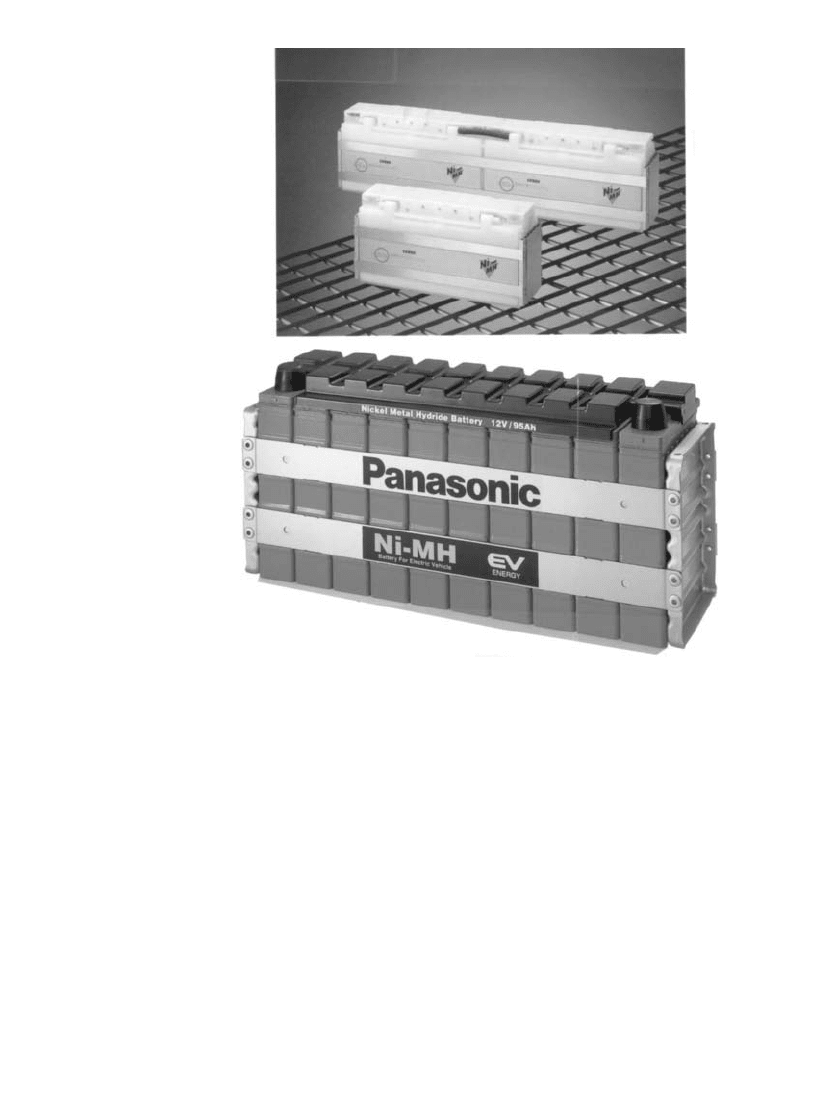Linden D., Reddy T.B. (eds.) Handbook of batteries
Подождите немного. Документ загружается.


29.32 CHAPTER TWENTY-NINE
29.7 PROPER USE AND HANDLING
Sealed nickel-metal hydride cells and batteries can give long-term maintenance-free, safe,
and reliable service if they are used in accordance with recommended procedures and are
not abused. They are sealed and can be used in any operating position. Other than charging,
the only maintenance that should be required is to keep them clean and dry during operation
and storage.
Most important, sealed nickel-metal hydride batteries, as most battery systems, should
not be exposed to extreme temperatures for any extended period. They can be stored, in a
charged or discharged condition, at moderate temperatures without detrimental effects.
Typically nickel-metal hydride batteries are shipped in a discharged state. However, as
some residual capacity may remain, caution should be exercised to avoid short-circuiting the
cell or battery.
After storage, or periods during which the battery has not been used, the battery should
be charged before being used. Overcharging or overheating the battery should always be
avoided.
It is possible that cells may vent if the cell or battery is overcharged or otherwise abused.
The nickel-metal hydride cell releases hydrogen gas during venting, which could form po-
tentially explosive mixtures with air. (Note that this differs from the nickel-cadmium cell,
which emits oxygen when it vents.) Caution should be exercised to prevent these gases from
collecting in the battery or equipment or from exposure to a source of ignition. Airtight
compartments should be avoided.
29.8 APPLICATIONS
The characteristics of the nickel-metal hydride battery present opportunities for use over a
wide range of applications. In the portable sealed configuration, it is being used in increasing
quantities in consumer electronic devices such as cellular phones, transceivers, computers,
camcorders, and other portable applications. In larger sizes, it is also one of the candidate
battery systems for use in electric vehicles, another important market for rechargeable bat-
teries in the next decade. (See Chaps. 30 and 37.)
A variation of the nickel-metal hydride cell is the silver-metal hydride cell where the
positive nickel oxyhydroxide electrode is replaced by a silver oxide electrode. The silver-
metal hydride cell has the advantage of a higher-energy density and better high-rate per-
formance, and may be useful in critical applications where its higher cost and shorter cycle
life is acceptable.
29.9 BATTERY TYPES AND MANUFACTURERS
Table 29.4(a–d ) lists some of the portable sealed nickel-metal hydride cells and batteries
that are manufactured and their physical and electrical specifications. Multicell batteries are
also manufactured using these cells or batteries in a variety of output voltages and config-
urations. Manufacturers’ data should be consulted for specific details on dimensions, ratings,
and performance characteristics as they may differ from those shown.
6

PORTABLE SEALED NICKEL-METAL HYDRIDE BATTERIES 29.33
TABLE 29.4a Specifications of Sealed Cylindrical Nickel-Metal Hydride Single-Cell Batteries,
Nominal Voltage: 1.2 V
Type
Capacity
(0.2C discharge)
(mAh)
Minimum Typical
Nominal dimension (mm)
Diameter
Height (H) Weight (g)
Standard series
AAAA
7/ 5 AAAA
300
500
310
520
8.4
40.6
66
6.5
10.5
1/4 AAA
1/3 AAA
1/2 AAA
2/3 AAA
4/5 AAA
AAA
9/ 5 AAAL
70
120
210
280
400
550
600
1100
80
130
230
290
450
600
630
1130
10
10.3
10.5
10.3
13.7
22
29
35.9
43.5
80
2.4
3.3
5.3
7.3
8.5
12.5
23
1/3 AA
2/3 AA
4/5 AA
AA
250
300
600
1200
600
1300
270
320
660
1250
660
1400
14.5
14.4
16.6
28.7
42.5
48.2
7
10
13
22
15
25
1/2 A
2/3 A
4/5 A
A
4/3A, 7/5A
600
1000
1810
2300
3500
650
1090
1870
2350
3580
17
17.2
22
28.7
43
50.2
66.7
14
22
32
40
52
1/2 N
N
18210
Sub-C
D
180
360
800
2200
4500
200
380
860
2420
4950
11.5
18.3
23
33
16.7
29.3
21.5
42.6
61.5
5.3
10
17
55
140
High capacity series
2/3 AAA
AAA
AAAL
7/ 5 AAAL
350
650
700
1000
380
670
720
1050
10
10.5
29
44.7
48
66.5
7.1
13
14.5
19.l5
2/3 AA
AA
AA
7/5 AA
750
1500
1600
1900
770
1540
1650
1960
14.5
14.4
14.5
28.7
48.2
49.2
65
15
26
26
40

29.34 CHAPTER TWENTY-NINE
TABLE 29.4a Specifications of Sealed Cylindrical Nickel-Metal Hydride Single-Cell Batteries,
Nominal Voltage: 1.2 V (Continued )
Type
Capacity
(0.2C discharge)
(mAh)
Minimum Typical
Nominal dimension (mm)
Diameter
Height (H) Weight (g)
High capacity series (Continued )
4/5 A
A
7/5 A
4/5 A, 7/5 A
2100
2500
3700
3700
2170
2550
3700
3800
17
17.2
17.5
43
50.2
66.7
67.5
32
39
52
53.5
N
18650
Sub-C
C
D
550
4100
3000
3500
7000
580
4200
3150
3850
7700
11.5
18.3
23
25.8
33
29.1
65.5
42.6
50
61.5
9.7
58
61
78.5
170
High temperature series
AA
4/5 AF
AF
18650
Sub-C
1250
1600
2100
4000
2200
1270
1660
2200
4100
2310
14.4
17
18.3
23
48.2
43
50.2
65.5
42.6
25.5
31
37.5
62
53
TABLE 29.4b Specifications of Sealed Prismatic Nickel-Metal Hydride Single-cell
Batteries
Nominal
voltage
(V)
Capacity
(0.2C discharge)
(mAh)
Minimum Typical
Nominal dimension (mm)
Thickness
(T)
Width
(W)
Height
(H)
Weight
(g)
1.2
400
500
700
800
1000
1100
440
550
750
850
1100
1200
6.1
6.1
6.1
6.1
8.3
6.1
17.0
17.0
17.0
17.0
17.0
17.0
31.3
35.3
48.0
48.0
48.0
67.0
10.3
12.0
17
17
22.0
23.0

PORTABLE SEALED NICKEL-METAL HYDRIDE BATTERIES 29.35
TABLE 29.4c Specifications of ‘‘9-volt’’ Nickel-Metal Hydride Batteries
Nominal
voltage
(V)
Capacity
(0.2C discharge)
(mAh)
Minimum Typical Nominal dimension (mm) Weight (g)
7.2
8.4
150 160 17.5(T)
⫻ 26.5(W) ⫻ 48.5(H) 39
42
TABLE 29.4d Specifications of Button Type Nickel-Metal Hydride Batteries
Nominal capacity at 5-hr rate (mAh) 11 15 25 40 80 150 250 320
Nominal dimensions Diameter (mm)
Height (mm)
Weight (g)
9.40
2.30
0.58
2.40
0.61
11.52
3.00
1.25
5.45
1.70
15.42
16.25
3.50
7.50
4.60
24.98
6.33
11.50
8.68
14.50
Source for Tables 29.4 (a to d): GP Batteries (USA) Inc.
REFERENCES
1. T. Sakai, ‘‘Hydrogen Storage Alloys for Nickel-metal Hydride Battery.’’ Zeitschift feur Physikalische
Chemie, Bd. 183, S. 333–346 1994.
2. L. Y. Zhang, ‘‘Rare Earth-Based Metal Hydrides and NiMH Rechargeable Batteries,’’ Rare Earths:
Science Technology & Applications 3rd Symp. Orlando, Fla., Feb. 1997; Minerals, Metals & Materials
Soc.
3. D. M. Kim, ‘‘A Study of the Development of a High Capacity and High Performance ZR-Ti-MN-V-
Ni Hydrogen Storage Alloy for NiMH Batteries,’’ 279 J. Alloys and Compounds, Oct. 1998, 209–
214.
4. John K. Erbacher, ‘‘Nickel-Metal Hydride Technology Evaluation,’’ Final Report Wright Laboratories
WL-TR—96-2069, Fairborn, OH, 1996.
5. D. Friel, ‘‘How Smart Should a Battery Be?, Battery Power Products & Technology, March 1999 and
commercial literature and data books from various battery manufacturers.
6. J. Norman Allen, ‘‘The Payoff in Smart Battery Electronics’’ Battery Power Products & Technology,
July 2000.

30.1
CHAPTER 30
PROPULSION AND INDUSTRIAL
NICKEL-METAL HYDRIDE
BATTERIES
Michael Fetcenko
30.1 INTRODUCTION
Nickel-metal hydride (NiMH) batteries are now in high volume commercial production for
small portable battery applications. The key driving forces for the rapid growth of NiMH
are environmental and energy advantages over nickel-cadmium and the explosive growth of
portable electronic devices such as communication equipment and laptop computers. Because
of its technical advantages over other rechargeable systems, this system is currently being
developed for large batteries, including industrial and electric vehicle applications.
The first introduction of electric vehicles began at the turn of the century, but was short-
lived after losing the competition to the Internal Combustion Engine (ICE). In the mid-
1970s, electric vehicles emerged again due to what turned out to be temporary gasoline
shortages. In the early 1990s, electric vehicles reemerged due to environmental air quality
concerns in urban areas. In particular, the California Air Resources Board (CARB) gave
electric vehicles tremendous attention by mandating that 2% of all vehicles sold in California
must be zero emission vehicles by 1998 and 10% of all vehicles by 2003. While the original
CARB mandate has changed, low and zero emission vehicles are still a high profile devel-
opment focus for vehicle manufacturers.
The California mandate led to the formation of the United States Advanced Battery Con-
sortium (USABC), an unprecedented cooperation between the major U.S. automakers, the
U.S. Department of Energy, and the electric utility companies. Besides providing a central
funding source for a multitude of competing technology development organizations, USABC
provided the battery performance targets shown in Table 30.1 along with a comparison to
current NiMH status.
More recently, there has been a significant shift by the automotive manufacturers from
electric vehicles toward hybrid electric vehicles (HEVs) due to several factors including
relaxation of the CARB mandate from zero to low emissions, customer reaction to initial
low range lead-acid electric vehicles, and the lack of geographically widespread EV charging
and fast charging stations.

30.2 CHAPTER THIRTY
TABLE 30.1 Primary USABC Midterm Performance Goals for the EV Battery and Actual
Performance of the Commercial and Advanced NiMH Battery
Property USABC
NiMH
Commercial Prototype
Specific energy (Wh kg
⫺
1
) 80 (100 desired) 63–75 85–90
Energy density (Wh per liter) 135 220 250
Power density (W per liter) 250 850 1000
Specific power (W kg
⫺
1
) (80%
DOD in 30 s)
150 (⬎200 desired) 220 240
Cycle life (cycles) (80% DOD) 600 600–1200 600–1200
Life (years) 5 10 10
Environmental operating
temperature
⫺30⬚ to 65⬚C ⫺30⬚ to 65⬚C ⫺30⬚ to 65⬚C
Recharge time
⬍6 hours 15 min (60%)
⬍1 hour (100%)
15 min (60%)
⬍1 hour (100%)
Self discharge
⬍15% in 48 hours ⬍10% in 48 hours ⬍10% in 48 hours
Ultimate projected price
(dollars per kWh) (10,000
units at 40 kWh)
⬍$150 $220–400 $150
30.2 GENERAL CHARACTERISTICS
Nickel-metal hydride batteries have become the dominant advanced battery technology for
EV and HEV applications by having the best overall performance to meet the requirements
set by USABC. In addition to the essential performance targets of energy, power, cycle life
and operating temperature, the following features of NiMH
1,2
have established this technol-
ogy in this market:
•
Flexible cell sizes from 0.3 to 250 Ah
•
Safe operation at high voltage (320⫹ V)
•
Excellent volumetric energy and power, flexible vehicle packaging
•
Readily applicable to series and series/parallel strings
•
Choice of cylindrical or prismatic cells
•
Safety in charge and discharge, including tolerance to abusive overcharge and overdis-
charge
•
Maintenance free
•
Excellent thermal properties
•
Capability to utilize regenerative braking energy
•
Simple and inexpensive charging and electronic control circuits
•
Environmentally acceptable and recyclable materials
Examples of EV NiMH battery packs for the General Motors EV1 and S-10 pickup truck
are shown in Fig. 30.1. In addition, nickel metal-hybride batteries are being used in industrial
applications, replacing nickel-cadmium batteries and are being considered as a replacement
for lead-acid batteries in SLI applications.

PROPULSION AND INDUSTRIAL NICKEL-METAL HYDRIDE BATTERIES 30.3
FIGURE 30.1 GM Ovonic NiMH battery packs for General Motors
EV1 (30 kWh) and Chevrolet S-10 pickup truck (30 kWh).
30.3 CHEMISTRY
The chemistry and chemical reactions for large propulsion NiMH batteries are the same as
in small portable applications, as discussed in Chap. 29.
The active material in the positive electrode is nickel hydroxide. Usually, the nickel
hydroxide has a conductive network composed of cobalt oxides and a current collector which
commonly is a nickel foam skeleton, but may alternately be a nickel fiber matrix or may be
produced by sintering filamentary nickel fibers.
3
The active material in the negative electrode is an alloy capable of storing hydrogen, and
usually of the AB
5
(LaCePrNdNiCoMnAl) or AB
2
(VTiZrNiCrCoMnAlSn) type, where the
‘‘AB
x
’’ designation refers to the ratio of the A type elements (LaCePrNd or TiZr) to that of
the B type elements (VNiCrCoMnAlSn). In either case, the materials have complex micro-
structures that allow the hydrogen storage alloys to operate in the aggressive environment
within the battery where most of the metals are thermodynamically more stable as oxides.
The metal hydride materials are conductive, and are applied to a current collector usually
made of perforated or expanded nickel, or nickel foam substrate. Copper current collectors
have recently emerged for extremely high rate discharge applications.
4

30.4 CHAPTER THIRTY
The electrolyte is also similar to small portable NiMH batteries, predominantly 6 Molar
KOHinH
2
O with a LiOH additive. Practically all NiMH batteries are sealed and use the
‘‘starved electrolyte’’ design, allowing for fast gas transport through the separator that is vital
for gas recombination. The separator itself is usually a highly porous permanently wettable
polypropylene, or it may be a polypropylene/ polyethylene composite made by either wet
laying of the fibers or by the ‘‘melt blown’’ process. In either case, the separator is usually
made wettable by a grafting process that bonds a material such as acrylic acid to the base
fibers by an energetic process such as radiation grafting. There are many variations within
the separators used by manufacturers and the processing details are proprietary.
30.4 CONSTRUCTION
30.4.1 Cylindrical Versus Prismatic Configuration
NiMH batteries are versatile in that both cylindrical and prismatic constructions can be
utilized. Each type of construction has advantages and disadvantages, and a particular end
use can determine which configuration is used. For NiMH applications below about 10 Ah,
cylindrical construction dominates due to low cost and high speed of manufacture. Above
20 Ah, cylindrical construction is extremely difficult and the prismatic configuration domi-
nates. In the 10 to 20 Ah cell size range, manufacturers are offering both cylindrical and
prismatic designs although prismatic designs are more common.
Cylindrical cells for industrial and propulsion applications are similar to high volume
production consumer batteries in that the well-known ‘‘jelly roll’’ construction is used. How-
ever, most small portable cylindrical cells require only low to moderate discharge rate ca-
pability and electrode terminal connections are usually quite simple. Conversely, since in-
dustrial and propulsion NiMH applications require high to ultra-high discharge rate capability
and low internal resistance, multiple tab current collection is used. This type of construction
is termed edge welding and requires each electrode to have a current collecting strip on one
side of the electrode. The current collecting strip for the positive and negative electrodes are
on opposite sides of the jellyroll. After coil winding of the jellyroll, the edge current collector
is welded in multiple locations to each electrode. Other aspects of cell assembly are virtually
identical to small consumer batteries. The net result of the enhanced current collection is a
reduction in cell specific energy and an increase in specific power due to decreased cell AC
impedance (usually around 8 to 12 m
⍀ for small portable batteries and around 1 to 2 m⍀
for industrial cylindrical cells). For industrial applications such as HEV, motorcycle and
electric bicycle applications, the most popular cylindrical cell sizes are standard C and D
sizes, although a multitude of height changes within those diameters are also used. Some
work on larger size cells such as the F size has also been reported.
5
Prismatic construction is conventional in that electrode stacks of alternating positive and
negative electrodes with intermediate separators are used (Fig. 30.2). The main design al-
ternatives involve the thickness and number of each electrode and the aspect ratio (relative
proportions of cell height to width to thickness). Key design variations include the ratio of
active materials to inactive components such as the cell can and terminal, and current col-
lectors. In all cases, the cell designer has the objective of emphasizing one or more properties
of performance such as energy vs. power, while maintaining a minimum threshold of other
performance factors such as cycle life. One example is that for EV NiMH prismatic cells,
6
a specific power of about 200 W/kg is acceptable for most vehicles and consequently,
relatively thick positive and negative electrodes can be used to increase the ratio of active
material to inactive cell components, allowing specific energy in the 63 to 80 Wh /kg range.
Alternately, HEV prismatic NiMH batteries typically must deliver greater than 500 W /kg
specific power and therefore electrode thickness must be lower than that for EV use. NiMH
batteries for HEV use have a typical specific energy ranging from about 42 to 68 Wh /kg.

PROPULSION AND INDUSTRIAL NICKEL-METAL HYDRIDE BATTERIES 30.5
Negative Terminal
Safety Vent
Positive Terminal
Electrode Tab
Positive
Electrode
Negative
Electrode
Cell Case
Separator
FIGURE 30.2 GM Ovonic 90 Ah Prismatic Cell and 13 V module.
30.4.2 Metal Versus Plastic Cell Cases
NiMH cylindrical cells exclusively use metal cell cases. One important reason is that the
can itself is electrically connected to the metal hydride negative electrode and serves as the
negative terminal. Another important reason is that many applications require fast charge
where gas recombination rates permit considerable internal pressure where only a metal
container would suffice without significant volumetric penalties. Finally, the metal crimp seal
to the cover plate assembly with a polysulfone seal ring is inexpensive, readily manufactur-
able, and reliable.
Both metal and plastic cell cases are common for the prismatic NiMH batteries used in
automotive applications such as electric vehicles. Unlike cylindrical cells where the can itself
is the negative terminal, prismatic design cells have both a positive and negative terminal at
the top cover plate. Key criteria for selecting metal cell cases include excellent thermal
conductivity, inexpensive prototyping costs for changing cell dimensions, and small volu-
metric penalties.
Advantages to plastic cell cases are cost and electrical isolation in the 320 V and higher
battery packs common to today’s electric vehicles, where even high resistance leakage cur-
rents to other vehicle components must be considered. Further design considerations for
plastic cell cases include development costs for permanent molds, gas permeation, thermal
conductivity, and sufficient plastic thickness for gas pressure containment without can wall
bulging. NiMH battery modules using plastic cell cases are shown in Fig. 30.3.

30.6 CHAPTER THIRTY
FIGURE 30.3 Plastic cell case NiMH module designs of SAFT (93 Ah,
64 Wh / kg) and Matsushita (95 Ah, 63 Wh / kg).
30.4.3 Sintered Versus Pasted Nickel Hydroxide Positive
Positive electrodes for use in NiMH batteries for industrial and transportation application,
whether cylindrical or prismatic, can be of the sintered or pasted type also common to NiCd
batteries.
Sintered electrodes have the best rate and power capability,
7
but sacrifice capacity on a
weight and volume basis and are more expensive to manufacture. Sintered electrodes involve
an expensive and complicated sequence of manufacturing steps, and consequently only com-
panies with an existing capital investment for this process would manufacture sintered elec-
trodes. Sintered positives begin with the pasting of filamentary nickel onto a substrate such
as perforated foil, where the nickel fibers are then ‘‘sintered’’ under a high temperature
annealing furnace in a nitrogen /hydrogen atmosphere and binders from the pasting process
are burned away to leave a conductive skeleton of nickel having a typical average pore
size of about 30 microns. Nickel hydroxide is then precipitated into the pores of the sinter
skeleton using either a chemical or electrochemical impregnation process. The impregnated
electrode is then formed or preactivated in an electrochemical charge/discharge process.
